These lithographic scenes from the Crimean War, based on sketches by William Simpson, were published in London in a couple of series by Colnaghi & co. in the second half of the 1850s. The illustrations here are all derived from .tif downloads and the images themselves are cropped back to the edges of the mounted borders. The scene keys or legends were cut from the sides of their corresponding prints and the deficits filled in. A few images have had background stains removed.
"The Crimean War (1853-1856) was a conflict between the Russian Empire and an alliance of the French Empire, the British Empire, the Ottoman Empire, and the Kingdom of Sardinia. The war was part of a long-running contest between the major European powers for influence over territories of the declining Ottoman Empire. Most of the conflict took place on the Crimean Peninsula, but there were smaller campaigns in western Anatolia, Caucasus, the Baltic Sea, the Pacific Ocean and the White Sea. In Russia, this war is also known as the "Eastern War" and in Britain it was also called the "Russian War" at the time."

Interior of the Malakoff with the remains of the round tower
"Print shows an interior view of the Malakoff, the main Russian fortification before Sevastopol, following the successful French assault."
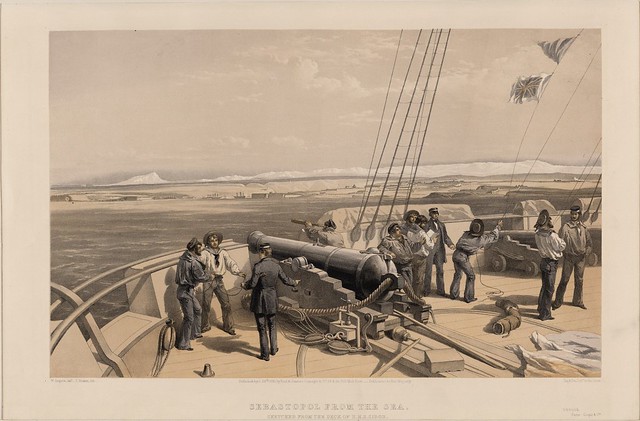

Sebastopol from the sea - sketched from the deck of H.M.S. Sidon
"Print shows sailors and cannons on deck of the H.M.S. Sidon, with a distant view of the forts and other buildings in Sevastopol."
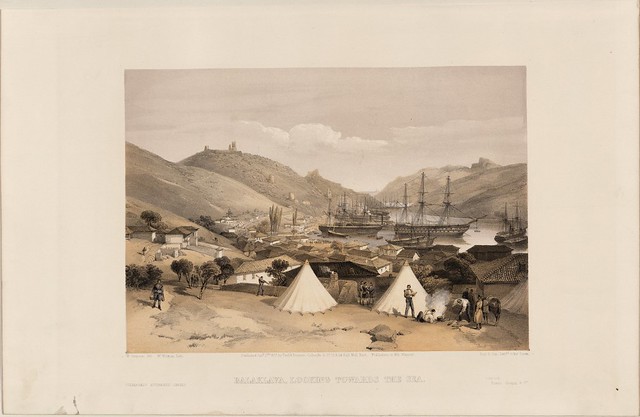
Balaklava, looking towards the sea
"Print shows view of Balaklava looking over the rooftops toward the harbor which is getting crowded with British ships; two bell tents in the foreground, and remains of an old castle on the hillside in the background."
"William Simpson arrived off the Crimean peninsular on November 15 and could hear distant firing. While he had missed the early battles, he was able to record the events before Sebastopol. He made numerous acquantances who helped him with details for his pictures, but he was also struck by the plight of the common soldiers, "miserable looking beings...covered with mud, dirt, and rags", he wrote. He hobnobbed with many officers including Lord Raglan and Captain Peel; he also met Roger Fenton who took his photograph. In May, 1855, Simpson accompanied Raglan on the expedition to Kertch which was captured on the 24th, but was back in time to observe the first attack on Sebastopol in June. On the night of the 17th, he crawled out of a trench to view the attack. He wrote, "It was a wild orchestra of sound, never to be forgotten." He was still at the front when the city finally surrendered, and he quit the Crimea in the autumn of 1855.
Throughout his time at the front, he would send back his watercolours to London where the lithographers of Day & Son would transfer them to stone. Simpson was paid 20 pounds for each picture. For the color, a separate stone was used for each tone. Colnaghis exhibited some of the watercolours, including a show at the Graphic Society in February 1855. The first advertisements for the lithographs appeared in May 1855 and in the following month, a second series was announced. In all, the Colnaghi's produced two large portfolios containing over eighty lightographs entitled The Seat of the War in the East. Two thousand copies of the complete set were produced. Simpson dedicated the series to Queen Victoria whose patronage he enjoyed for the rest of his life, and he was a frequent visitor to Windsor Castle and Balmoral. So popular were his pictures that he became affectionately known at 'Crimean Simpson'. [source]
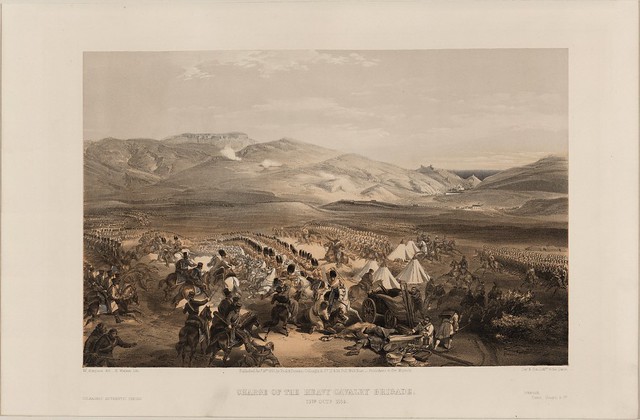
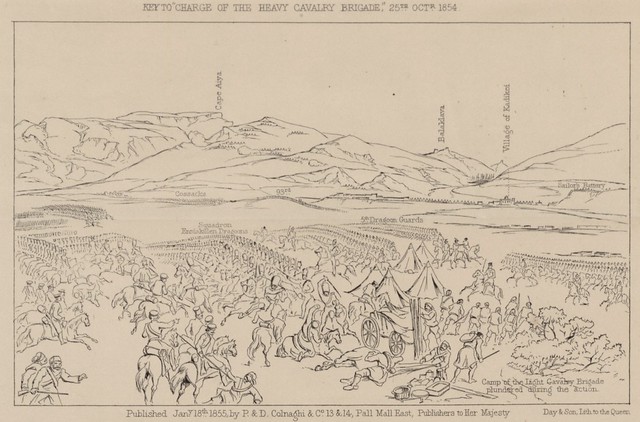
Charge of the heavy cavalry brigade, 25th Octr. 1854
"Print shows the Enniskillen Dragoons and the 5th Dragoon Guards engaging the Russian cavalry in the midst of the camp of the light cavalry brigade which is being plundered by the Russian troops during the battle of Balaklava."

The railway at Balaklava, looking south
"Print shows the railway under construction in Balaklava near the harbor, also shows masts of ships in the harbor and the ruins of the old Genoese castle on a hill in the background."
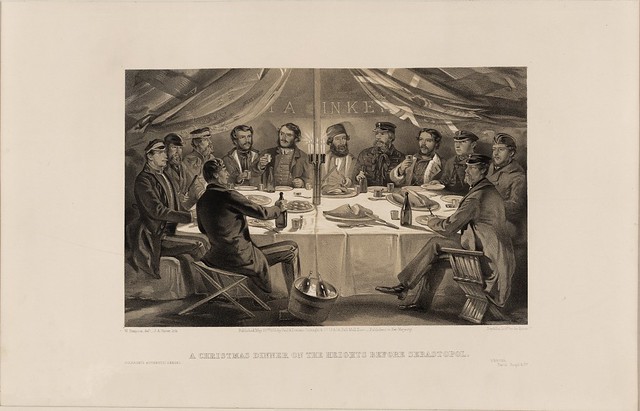
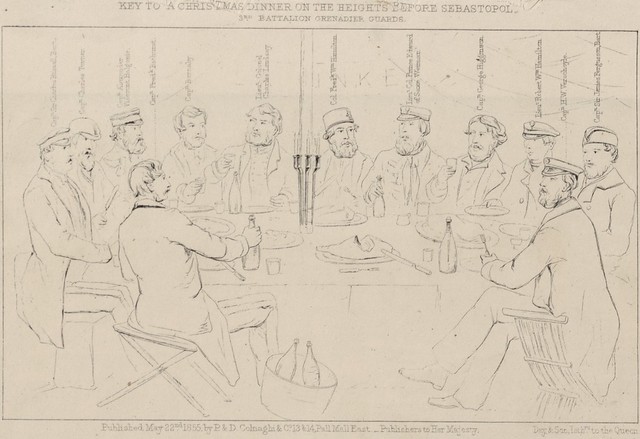
A Christmas dinner on the heights before Sebastopol
"Print shows (from left) Capn. Sir Charles Russell, Bart, Capn. Charles Turner, Capn. Alexander Viscount Balgonie, Capn. Fredk. Bathurst, Capn. Burnaby, Lieut. Colonel Charles Lindsay, Col. Fredk. Wm. Hamilton, Lieut. Col. Prince Edward of Saxe Weimar, Capn. George Higginson, Lieut. Robert Wm. Hamilton, Capn. H.W. Verschoyle, and Capn. Sir James Fergusson, Bart seated around a table in a tent, enjoying a Christmas dinner."
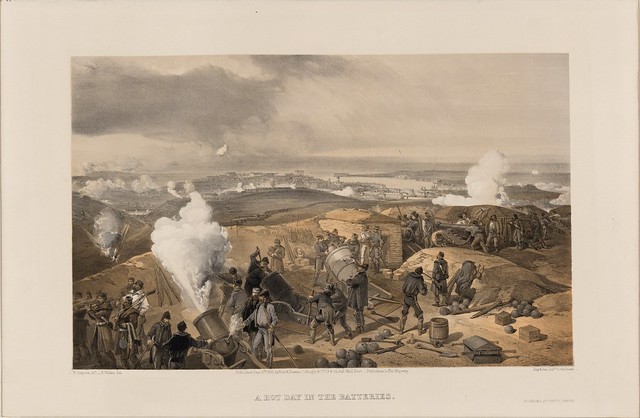
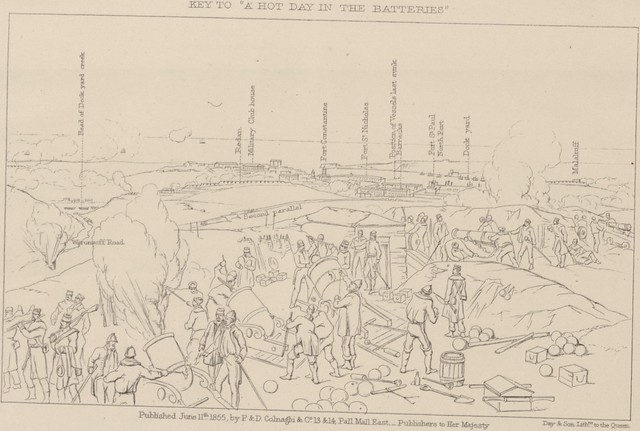
A hot day in the batteries
"Print shows action in a British artillery battery, mortar fire, mortars and cannon being loaded, the removal of wounded, and in the distance, the fortifications of Sevastopol."
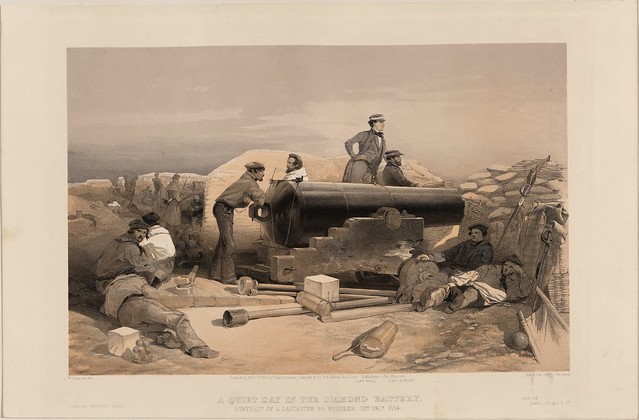
A quiet day in the diamond battery -
portrait of a Lancaster 68 pounder, 15th Decr. 1854
"Captain Peel, son of Sir Robert Peel, stands by the Lancaster 68-pounder, while his men keep their heads below the parapet of the battery." [source]

A hot night in the batteries
"Print shows action in a British artillery battery with cannons firing and being loaded, and men bringing in supplies."
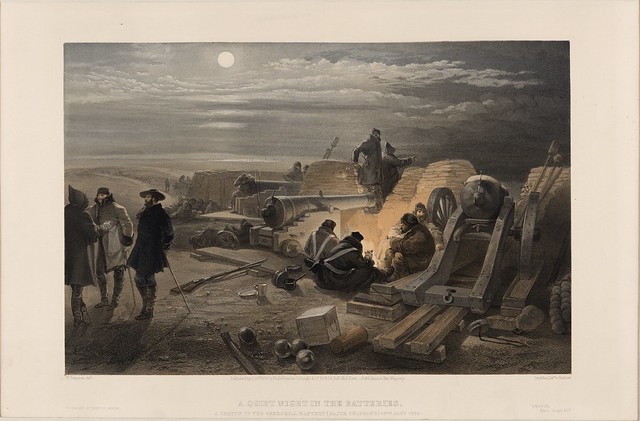
A quiet night in the batteries
"A sketch in the Greenhill battery (Major Chapman's), 29th Jany. 1855" | "Print shows men and cannons in a British artillery battery, at night."
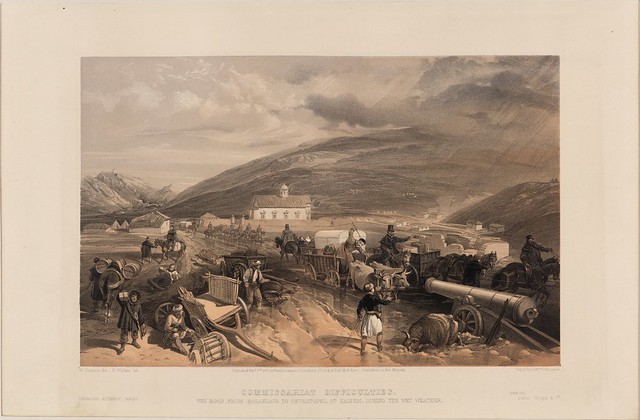
Commissariat difficulties - the road from Balaklava
to Sevastopol, at Kadikoi, during the wet weather
"Print shows wagons and a cannon mired in mud, broken wagons, and dead or dying horses and oxen on the roadside, at Kadikoi, on the road to Sevastopol"

Embarkation of the sick at Balaklava
"[This] tinted lithograph, [..] shows injured and ill soldiers in the Crimean War boarding boats to take them to hospital facilities. Modern nursing had its roots in the war, as war correspondents for newspapers reported the scandalous treatment of wounded soldiers in the first desperate winter, prompting the pioneering work of women such as Florence Nightingale, Mary Seacole, Frances Margaret Taylor and others." [source]
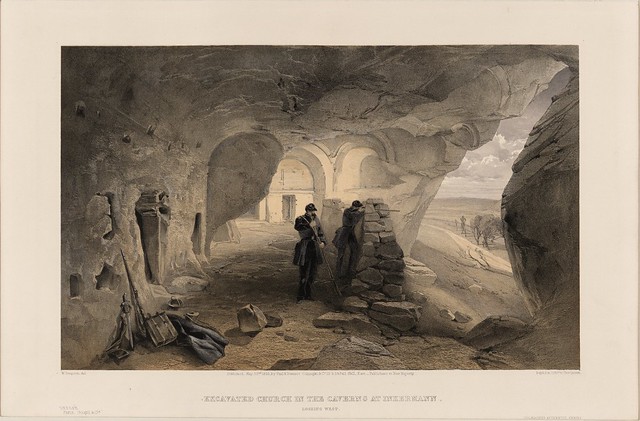
Excavated church in the caverns at Inkermann - looking west
"Print shows interior view of cavern church showing remains and two soldiers firing over a wall at the entrance to the cavern."


Highland Brigade camp, looking south
"Print shows an artillery battery with Capn. Mansfield, Major Shadwell, Lieut. Col. Stirling, Major Gordon, and Sir Colin Campbell standing near the cannons, with the camp of the Highland Brigade, showing huts and tents, in the background; the harbor at Balaklava and the remains of the old Genoese castle are visible in the distance on the right."

Sentinel of the Zouaves, before Sevastopol - The seat of war in the East
"Print shows a soldier standing guard at a French battery with snow-covered cannons and Zouaves carrying bundles of wood to a camp in the background." & "Two sentinels with fixed bayonets patrol a gun emplacement, while three figures cross the area carrying firewood" [source]

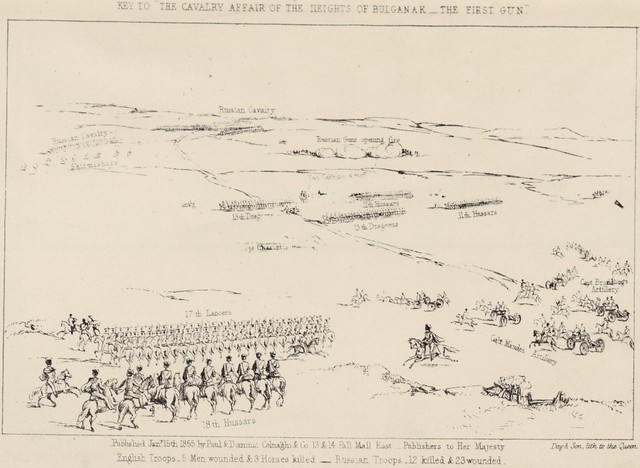
The cavalry affair of the heights of Bulganak - the first gun, 19th Sepr. 1854
"Print shows expansive view of the countryside, the Russian cavalry and artillery in the distance, Russian guns opening fire on British troops as they draw up into formation."
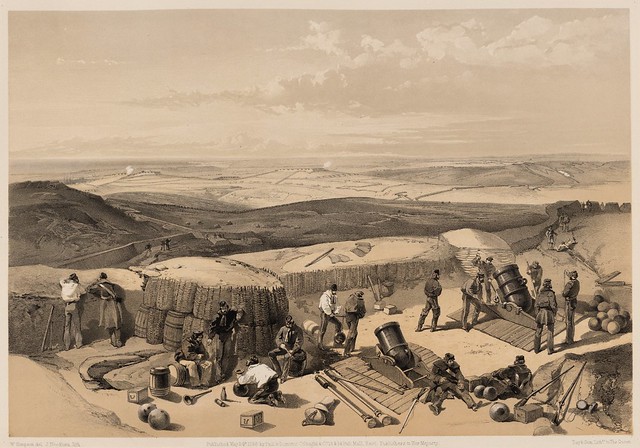

The new works at the siege of Sebastopol on the right attack -
from the mortar battery on the right of Gordon's battery
"Print shows a mortar battery with soldiers, two mortars, gabions, and earthworks, with a distant view of Sevastopol." & "Guns and ammunition being prepared for action behind earthworks in the foreground, the Russian defences are visible in the distance." [source]
Google books limited excerpt from: 'The Campaign in the Crimea. An Historical Sketch' 2002 by George Brackenbury.
[unless otherwise stated, all commentary above is quoted or paraphrased from the LoC]
--click through on any image above for a greatly enlarged version--
--click through on any image above for a greatly enlarged version--
- The lithographs of Crimean War scenes - 'The Seat of War in the East' - after watercolour sketches by William Simpson, come from the Library of Congress Popular Graphic Arts Collection (search result) in the Prints & Photographs Online Catalog (PPOC).
- You can see a quick overview of a different batch of lithographs from this same print series at Heaton's.
- The British Museum has about twenty original watercolour sketches for the Crimean set(click 'all objects' adjacent to Simpson's name) [The BM also has a fair number of lithographic prints from 'The Seat of War in the East' set]
The BM biography of William Simpson: "Draughtsman, early lithographer, watercolour painter, journalist and antiquarian. Covered the Crimean war on behalf of Colnaghi's but later joined the 'Illustrated London News' and covered the Abyssinian campaign (1868), Franco-Prussian war, Modoc war (1873) and Second Afghan war. Buried in Highgate Cemetery in London. A number of watercolours made by Simpson during his time in the Crimea, Magdala and Afghanistan are in the British Museum, along with a small number of archaeological and ethnographic items."
No comments:
Post a Comment